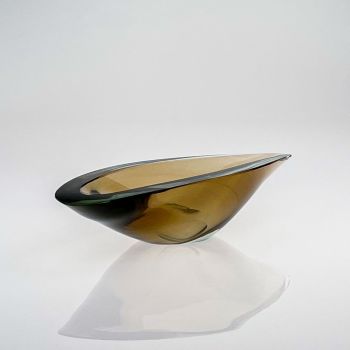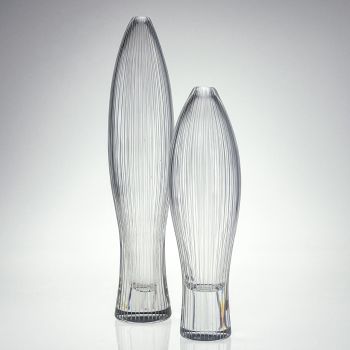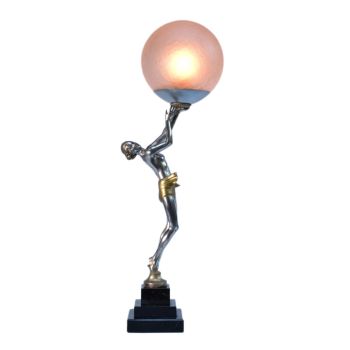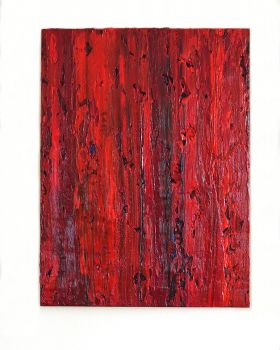A staved teakwood “Congo” icebucket – Dansk Designs, circa 1965 1960 - 1969
Jens Harald Quistgaard
MaderaTeca
40 cm
ConditionVery good
€ 675
Van Kerkhoff Art
- Sobre la obra de arteA staved teakwood “Congo” lidded icebucket with a black plastic inner liner. Designed by Jens Quistgaard in 1955 and produced for Dansk Designs probably in the late 1950’s or early 1960’s.
These icebuckets were made in three different size ranges, this being a middle sized example. These objects were made with great craftsmanship.
Strips of solid teakwood (staves) were joined together in a traditional way to form the final shape. The craftsmanship originates from the tubing of buckets and barrels and has been practised in Scandinavia since the middle ages.
The ice bucket is branded underneath the base: “four Ducks mark” – which identifies the bucket as an early production piece – Dansk Designs Denmark – JHQ (Jens Harald Quistgaard) and ©.
About Jens Harald Quistgaard
Jens Harald Quistgaard (Copenhagen 1919 – Vordingborg 2008) was a Danish wood-, metal- and glassware designer and sculptor, known principally for his work for the American company Dansk Designs, where he was chief designer from 1954 until 1983. Jens Harald Quistgaard grew up in an artistic family in Copenhagen. His father, Harald Quistgaard, tought him sculpting at a young age. He was educated as a drawer and silversmith at the technical school in Copenhagen. His apprenticeship he served at Georg Jensen Sølvsmidie.
After World War II Quistgaard set up his own design studio in Copenhagen. His breakthrough as an designer came in 1953–54, where he fashioned the cutlery set Fjord, the first cutlery set that combined stainless steel with handles of teak.
In 1954 was awarded the gold medal at the Triennale in Milan for a saucepan design. For two more reasons 1954 became a very important year for Quistgaard. He received the prestigious Lunning Price – informally called the “Nobel price for design” – and he started to work together with the American businessman Ted Nierenberg.
Together they founded the American company Dansk Designs with Quistgaard as chief designer. His designs were an immediate success in the USA and his designs were synonymous with modern living and Scandinavian style, consisting of clean lines, sculptural form and natural materials.
From the 1960’s onward his success in The united States was followed by success in Europe and Japan. Dansk Designs started their own shop in Copenhagen, in London and in Stockholm, and Quistgaard’s designs were exhibited and sold in Tokyo, Berlin, Paris, Zürich, Melbourne, Johannesburg and many other major cities.
Quistgaard remained chief designer for Dansk Designs until the 1980’s. In 1983 he moved to Rome and in 1993 he returned to Denmark.
His work is represented in many museums all over the world, among others: The Louvre, Paris; Designmuseum Danmark, Copenhagen; The British Museum, London; The MoMa, New York City and the National Museum, Stockholm.
Marked
Branded underneath the base:
"Four Ducks" Mark – Dansk Designs Denmark – JHQ (Jens Harald Quistgaard) and ©
Execution
made for Dansk Designs in Denmark, circa 1965
Condition
Good original condition, some minor scratches, stains and dents. Wear consistent of age and use.
Literature
Mel Byars – The Design Encyclopedia, p. 605-606
Dimensions
Height 40 cm - Sobre el artista
Jens Harald Quistgaard (23 de abril de 1919 - 4 de enero de 2008) fue un diseñador danés mejor conocido por sus creaciones para Dansk, donde trabajó como diseñador jefe desde mediados de la década de 1950 hasta la década de 1980. Durante su carrera, Quistgaard diseñó más de 4000 objetos, haciendo una importante contribución al diseño moderno.
Nacido en Copenhague el 23 de abril de 1919, Quistgaard creció en una familia artística, donde su padre, Harald Quistgaard (1887-1979), era escultor y su madre pintora. A la edad de catorce años, Jens Harald Quistgaard comenzó a experimentar con la fabricación de joyas y cuchillos. Después de su educación en la escuela técnica, fue aprendiz de artesanos de renombre como Georg Jensen y Just Anderson.
Durante la Segunda Guerra Mundial, Quistgaard participó activamente en la resistencia danesa. Después de la guerra, sus diseños se exhibieron en varias exposiciones en Europa y Estados Unidos.
Un punto de inflexión en su carrera llegó con la creación de la cubertería "Fjord" en 1953, en la que Quistgaard combinó madera de teca con acero inoxidable. El diseño llamó la atención del empresario estadounidense Ted Nierenberg, quien se acercó a Quistgaard con una propuesta para producir el juego de cubiertos a gran escala. Así nació Dansk International Designs en 1954, con Quistgaard como diseñador jefe. El juego de cubiertos Fjord se introdujo en las tiendas estadounidenses en 1956 y rápidamente se convirtió en un gran éxito.
Además de cubiertos, Quistgaard también diseñó una extensa colección de molinillos de pimienta, ensaladeras y tablas de cortar para Dansk. Fue conocido por el uso de la madera en sus diseños, especialmente la madera de teca, pero también maderas más exóticas como el wengué, el cocobolo y el palo de rosa.
Quistgaard recibió varios premios prestigiosos por sus diseños innovadores, incluidas medallas de oro y plata en la Trienal de Milán de 1954 y el Premio Lunning. En 1958 fue galardonado con el Premio Neimann Marcus. Quistgaard continuó trabajando en Dansk hasta la década de 1980, donde creó continuamente diseños innovadores y atemporales.
El legado de Jens Harald Quistgaard sigue vivo en el mundo del diseño, donde sus creaciones atemporales y funcionales aún son apreciadas por entusiastas de todo el mundo. Su influencia en la comunidad de diseño danesa e internacional será recordada para siempre.
¿Está interesado en comprar esta obra de arte?
Artwork details
Related artworks
Børge Mogensen
Teak wood “dropleaf” desk – Søborg Møbler, Denmark circa 19551950 - 1960
Preis auf AnfrageVan Kerkhoff Art
1 - 4 / 24Børge Mogensen
Teak wood “dropleaf” desk – Søborg Møbler, Denmark circa 19551950 - 1960
Preis auf AnfrageVan Kerkhoff Art
Unbekannter Künstler
A Japanese bronze Hu flower vase, Edo / Meiji, 19th century19th century
Preis auf AnfrageMenken Works of Art
1 - 4 / 24Børge Mogensen
Teak wood “dropleaf” desk – Søborg Møbler, Denmark circa 19551950 - 1960
Preis auf AnfrageVan Kerkhoff Art
1 - 4 / 24- 1 - 4 / 12














































































